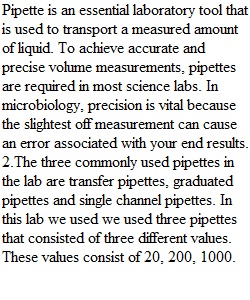


Q Required Resources • Complete the Week Prelab Activity (Connect) Instructions Welcome to the (online) lab page. You should have already completed the Lab Safety virtual lab simulation on Labster. Here is where you will upload your completed lab document. Grading This activity will be graded using the rubric in the lab document. Course Outcomes (CO): 1 Due Date: By 11:59 p.m. MT on Sunday Lab 5: Pipetting Learning Objectives • Select the correct micropipette for its purpose. • Use the two stops of the pipette. • Explain pipetting techniques. • Perform a serial dilution. • Quantify the protein content in a sample with a Bradford assay. Introduction: Master pipetting virtual simulation lab In the Pipetting simulation, you will determine the amount of essential amino acids in genetically modified corn. Using a micropipette, you will prepare a serial dilution, and measure the protein concentration with a Bradford assay. Get to know the micropipette You will be introduced to the basics of pipetting as you dive right into the experiments. Step by step, you will learn how to adjust the volume, use the two ‘stops’ of the pipette, and find out which pipette to use for which volume range. You will also learn tips and tricks to make your pipetting more accurate. Perform a serial dilution Once you master the art of pipetting, you will dilute your protein solution 10.000 fold! While you progress through the lab, the technique will become more routine. After this mission, you will understand the benefits of serial dilutions, and be able to perform one by yourself. Measure the protein content in the sample In this mission, you will dye your proteins blue, and use your new skills to prepare a microplate for a Bradford assay. In this colorimetric assay, you shine light of a specific wavelength through the plate, and measure the absorbance in each well. Finally, you will compare the absorbances of your sample to a sample of known protein concentration. Will you be able to calculate the amount of essential amino acids in the corn cob you collected? Questions: 1. Purpose: Why is proper pipetting important in a microbiology lab?
Q 2. What are the three different types of pipettes that are commonly used in lab?3. List 4 safety features that you will need to follow when using pipette? 4. Reflection: Write 5 sentences on what you learned from this simulation. What did you like and what was something that you would prefer not be a part of this simulation?
View Related Questions